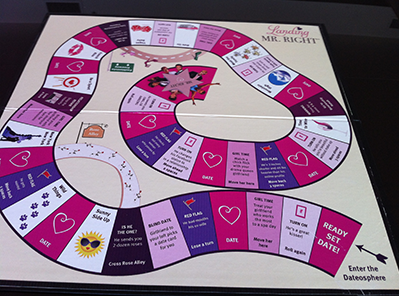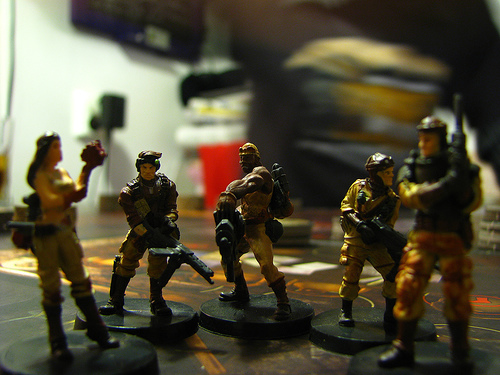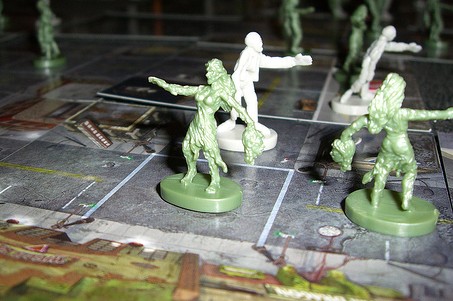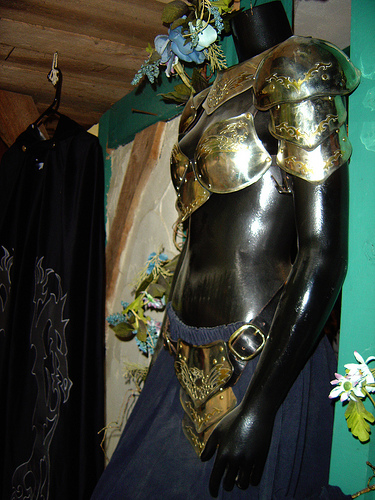I know that if there’s one thing every woman needs, it’s a man. For those poor, unfortunate spinsters who’ve yet to find their own personal Mr. Darcy/Edward Cullen/Ironman (choose according to your tastes/insecurities), it’s only natural that they spend every free moment lamenting their past romantic failures and concocting intricate fantasies. If only it weren’t so difficult to get women to sit down and open up to one another about their romantic lives.
At least, that’s what I assume the designers of Landing Mr. Right must believe. If not, then they’re master satirists, and I stand corrected.
Let me begin by acknowledging that had this game not so thoroughly angered me, it never would have made it onto this site. It’s a Roll And Move game, and it’s obviously not targeted at a wide range of gamers. It’s for the more social, casual crowd – which is not to denigrate social/casual games – but to specify that they’re not what we generally devote a ton of our space to. Given these limitations, I’m not going to spend a great deal of time talking about the game itself. This is not a review.
So, given that major caveat, I have the following to say: this game angers me. More than that, it saddens me. Alys and Victoria,the women behind this game, attempted to create a game about women, about their relationships and struggles, but from where I’m standing, they succeeded in creating a game about men, and women’s relationships to them.
That’s the part that makes me angry. Here’s the part that makes me sad: making a game is difficult, and the designers of this one not only developed a game, but she successfully prepped it for production, managed to get press for it, created a website for it . . . and yet their marker for success still seems to be finding a man.
Ostensibly, yes, the game is about bonding with your female friends, about sharing and validating experiences, about building communication. These are legitimate goals, as is finding a partner to share your life with (if you’d like). But here, no matter how close you get to your friends, or how much personal growth you go through, you win by finding a guy. You don’t win by deciding that now is not the best time to be in a relationship and that you’d like to focus on your career. You don’t win by spending more time with your family or pursuing a hobby. There is only one win condition, and it isn’t even about you, really.
And, on the surface, that’s not necessarily a problem. A lot of games only have one win condition. You can’t pull off a cultural victory in Risk, and you can’t go the philanthropic route in Monopoly. But for a game that’s billed as “therapy in a box,” as lighthearted as their intentions may be, the designers of Landing Mr. Right seem to have missed an important point: you do not need to find a husband in order to win.
Sigh. I think it’s time to move away from Landing Mr. Right.
Women in Games
I like to think that in the realm of “designer” games, feminism has made more progress than it has in the general market. I realize that part of this is just my own luck and privilege, and I’d love to discuss this in depth another time.
As a feminist gamer, then, I’m usually happy.
As a feminist game reviewer, though . . . well, not so much.
Don’t get me wrong. There has been immense progress. There are more women, people-of-color, and LGBT folks in the industry than ever before, and the diversity is beginning to show. Particularly among indie games, which is our focus here at the CR, feminism and inclusivity have made great strides.
There’s still a ways to go, of course, and there’s still a fair amount of backlash. But if progress was easy, everyone would do it. I see a game about once every month that I refuse to cover based on its derogatory content. And it’s always a struggle to figure out when to cover something negatively and when not to cover it at all. Is there truly no such thing as bad publicity? Again, that’s a topic for another article.
Most times, I think such negative content is based on ignorance. That’s not much of an excuse in 2013, but some people just need things spelled out for them. In that respect, I’m happy to help – after all, the fewer sexist/racist/homophobic/transphobic/etc. games that are out there, the less often I have to become angry.
Here are, then, a couple reminders to that end. To preface though, this is meant as a relatively light list. There are only three items, and I chose them because they’re the ones I see every day. There are just as many ways to make a non-feminist game as there are to make a feminist one, and I’ve only scratched the surface here. Most of these should come as no surprise.
1. Females should make up roughly half of your total characters
Women comprise approximately 50% of the population, and this should be reflected in your game.
Now, please don’t argue that you would do this, only your game is about X, and there were no women involved in X. Unless your game is about a medieval monastery, there were likely women involved. Women have gone to war since the beginning of conflict. Women were pirates and hackers and leaders and doctors and settlers. If it happened, women were there, though their participation did not often make the history books. Please don’t continue to take away their voices and their effort.
Take Arkham Horror, for instance. This is a game set in the 1920s, arguably past the peak of the Progressive Era (though, all things considered, not that bad). Women make up a significant portion of the playable characters, though, and they are just as varied and skilled as the men. You can play a woman and be a healer, a fighter, or a gate-jumper. They are given just as much attention and detail as the male characters, though it would have been easy given the setting and the source material to relegate them to supporting roles.
Even in games where players don’t take on the roll of a specific character, if men are represented in your game, women should also be represented. If you have, for instance, a card game set during the zombie apocalypse, and each card represents a zombie or a survivor, there should be female zombies and female survivors.
2. Clothe. Female. Characters.
Well, clothe them to the same extent that you clothe male characters. If everyone is running around mostly-naked in chainmail bikinis, then by all means have your swordswoman rock some boob window.
But, if your menfolk are mostly covered (whether for battle or plundering or whathaveyou), have the decency to mostly cover your womenfolk as well.
This is actually the biggest problem in my experience. There are so many miniature games that I’ve turned away from because their models contrasted large, strapping men in full plate with weak, tiny women in metal loin cloths. I mean, come on. Who wants to run into battle with all of their most sensitive and vital body parts completely unshielded?
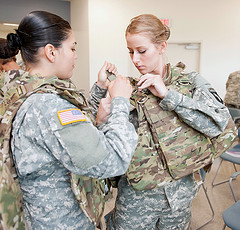 If there was ever a time to put comfort and safety over beauty, war would be it.
If there was ever a time to put comfort and safety over beauty, war would be it.
3. Assume that women will play your game
Then, embrace that assumption. Include female pronouns and examples of female players and characters in your rule book. If your game is all about manly men doing manly things, put some badass women in there. Include a few Dana Scullys and Ripleys and Joan of Arcs.
Alternatively, let players have more control over the narrative. Obviously, this works best in roleplaying games, but board games such as Android and Arkham, with their elaborate narrative structure, benefit a great deal from player choice and interaction. Give players real control and let them play the game that they want.
The stereotype still exists that gaming is overwhelmingly male, but it should not be a shock nowadays that a lot of women do play games – and that number is growing.
I’m not demanding perfection. Feminism is a learning experience. Progress is a slow, jerky march toward the future, and when you stumble or miss a step, you have to pull yourself back into stride and try not to make the same mistake again. If you follow these points, though, you’ll at least demonstrate that you’re trying.
TL;DR: Make a game about people, not a game about men. Your game will be better for it, I promise you.
![]()
Erin Ryan is a regular contributor to the site, and an ardent supporter of functional female armor. Feel free to share your thoughts with us over on our social media pages!
Photo Credits: Squad Pieces by Peter Hellberg; Female Zombies by scurzuzu; fantasy “armor” by greyloch; Female Soldiers by JBLM PAO.

